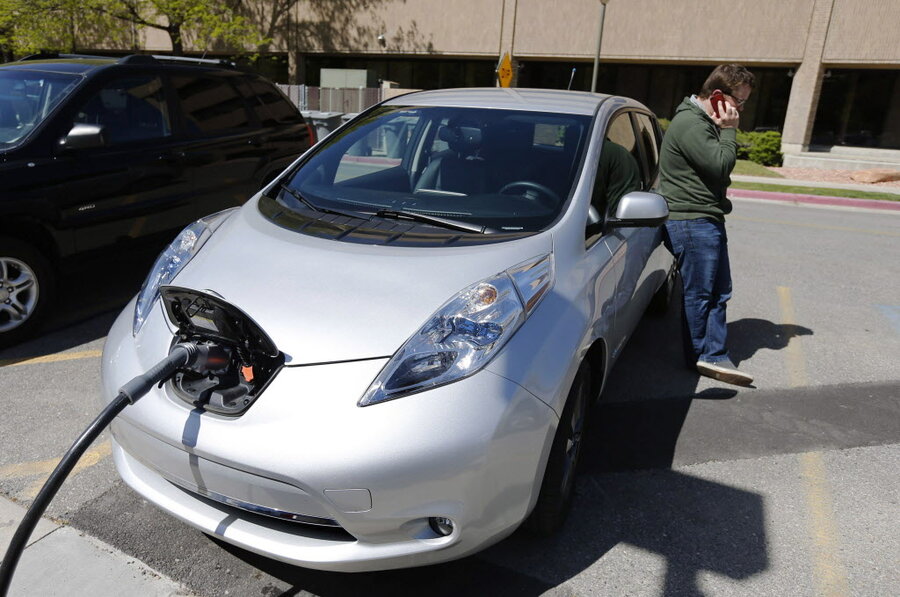Electric-car buyers expect battery upgrades
Loading...
With battery-electric cars now on the market for five years, and perhaps 200,000 on U.S. roads, we now know more about how the cars and their drivers behave in the real world than we did when they first arrived.
One learning is that an undercurrent among some electric-car buyers that suggests they fully expect carmakers to offer future battery upgrades that providesignificant range boosts.
This, it seems fair to say, both startles and baffles automakers.
Those buyers, used to upgrades in their mobile phones as often as every 18 months, seem to view their electric cars not as automobiles but as consumer-electronics devices.
And they expect the pace of change in technology to be far more rapid for electric powertrains than for conventional internal-combustion engines.
There's some justification for this view.
While battery technology does not improve at the same rate as that of microelectronics (famously codified in Moore's Law), lithium-ion cells have a historic rate of cost-performance improvement of roughly 7 percent over more than 20 years.
Automakers, however, have spent more than a century designing, testing, building, and selling cars--and then thinking about them as little as possible.
And future upgrades to vehicles simply haven't been a design consideration.
Consider the response by a Ford Motor Company executive when asked about whether its new Sync 3 system could be retrofitted into cars of the last three years equipped with the earlier and much-reviled MyFordTouch system.
"The upgrade path," he said firmly, "is a new vehicle."
Nissan, similarly, offers no provision for fitting its new 30-kilowatt-hour battery pack from the 2016 Nissan Leaf (rated at 107 miles) into earlier Leafs that came with 24-kWh packs, even though the form factor appears to be identical.
Nissan representatives in several countries have said the company has no plans to offer retrofits. It has said it will offer replacement 24-kWh packs using the latest heat-resistant chemistry for $5,500, but they are not upgrades.
The only electric cars for which battery upgrades are available now, in fact, are roughly 2,000 Tesla Roadster 2.0 or 2.5 models. They can be upgraded to a new "Roadster 3.0" pack that fits in the original space that will provide "over 35 percent more range" for $29,000.
In part, this is because all makers design their packs to last the life of the car--at least 10 years, and generally as much as 15 years.
Packs are customarily warranted against failure for at least eight years, but warranties against anticipated capacity loss are rarer and vary by manufacturer.
But what if battery packs were not designed to last for 10- or 15-year vehicle lifespans?
That's the intriguing question raised during a lengthy interview with Denise Gray, the new CEO of LG Chem Power, the U.S. battery arm of Korean conglomerate LG Chem.
That company has provided the cells for both generations of Chevrolet Volt range-extended electric cars, and is widely presumed to be the supplier for the Chevy Bolt EV as well. It also supplies cells for vehicles from Audi, Ford, Hyundai, Renault, Smart, Volkswagen, Volvo, and others.
Among other positions in a career of more than 20 years at General Motors, Gray was director of global battery systems engineering. In that role, she oversaw the laboratory that tested and validated cells from various makers and the designs for the first-generation Volt battery pack.
She left in 2010, just before the Volt went on sale, to join startup battery-pack integrator Atieva, where she gained an understanding of the Chinese plug-in vehicle landscape and its manufacturers' requirements.
Suppose, Gray asked, carmakers only specified battery packs that were only intended to last for half a car's life: five to seven years, say?
That would greatly reduce the cost, redundancy, and perhaps even the size and weight of batteries that would not need to have sufficient capacity to last 10 to 15 years, she suggested.
Design for future upgrades is something that engineers who work with electrified powertrains generally have in mind, she said.
But, historically, it's rarely prioritized over the more traditional view that, "You've got 'em for life"--and the time, effort, and priorities of getting a vehicle with an advanced powertrain out the door on schedule with the necessary high reliability and lowest possible costs.
But the very fact that Gray raised the idea suggests that it's at least being discussed among automakers looking at larger volumes and more diverse plug-in offerings for 2020 and later.
Which poses all sorts of interesting questions, including how on earth the automakers would market a car that needed a $5,000 to $10,000 component replaced after five to seven years.
Stay tuned on that one.
This article first appeared at GreenCarReports.







